The recent roundtable on Likewise and Ariel Schrag produced a number of helpful comments but there was one in particular which made my ears prick up:
“I actually think Fun Home works best as prose (not sure about Schrag’s work). It’s a beautifully written novella/short story, really…and rarely (to me) does the art add much to that. For that reason, I kind of think it’s not really such a great “graphic memoir”–It doesn’t really use the “graphic” tools to great effect–as Maus, for instance, does (sorry Noah).”
These comments were made by Eric B. in relation to my own concerning the difficulties I had with Schrag’s art. Fun Home was not a work which I read particularly intently at the time. In a sense, I let it wash over me like any average reader would. Still my memories of the work were far from unpleasant and Eric’s statement did seem a bit at odds with what I experienced.
In my current rereading, I’ve found Fun Home to be reasonably sophisticated from a graphic standpoint. Bechdel doesn’t use a lot of the “tricks” currently favored by the comics avant-garde but her narrative techniques do tread gently into areas which work best in more static visual forms.
Much of the book’s appeal to general audiences must lie in the way it gently eases readers into the comics medium. The liberal use of literary references helps in this respect of course, but we also never encounter the sharp, disorienting disruptions in space and time so favored by Gilbert Hernandez or the elusive multi-directional panel layouts of Chris Ware.
The opening pages of Fun Home will serve as well as any at demonstrating Bechdel’s art. Here, simple and somewhat ironic illustrations of the text imperceptibly guide the reader through an engagement with both words and images. So we have the words “launch”, “acrobatics” and “Icarus” hovering above drawings which seem to suggest the same. Another panel recalls Pieter Breughel’s The Fall of Icarus but with some mild dissonance where the text reads:
“In our particular re-enactment of this mythic relationship, it was not me but my father who was to plummet from the sky.”
[Detail from The Fall of Icarus]
The strain of irony in these opening pages is seen again on page 7 which opens with a moment of careless pomposity as Bechdel’s father unilaterally decides on the wall coverings for her room; a segment which is followed by the more detached and austere atmosphere of his work place with its shaded windows. The final panel provides a short summation of this equation:
“It was his passion and I mean passion in every sense of the word. Libidinal. Manic. Martyred.”
We are presented, by way of illustration, with a picture of a latter day saint on his way to his personal Golgotha. This may seem heavy-handed and obvious to some but there’s a fine balance to be met between that which is immediately apparent and that which is so obscure as to slip by on a casual reading.
Bechdel is certainly capable of a bit more subtlety in service to her plot. On page 14, the reader is presented with a series of mirrors. The first is a television screen (showing Bert and Ernie) reflecting the gaze of the children who recline in front of it.
[Page 14 and 15 of Fun Home]
The second to last panel shows a mirror with an image of Bechdel’s father as he looks back at the reader with an artist’s commanding gaze. It’s not quite Las Meninas but there’s a hint of distant ancestry. The facing page shows her father holding a copy of Kenneth Clark’s The Nude which further suggests that pretensions to fine art (not to mention an interest in the male nude) were never far from this thoughts. Page 14 is in fact a preface to a series of opposites. The first of these is submitted via the aforementioned series of mirrors, which then lead on to a series of reflections on page 15.
An array of lies is rehearsed over the next 2 pages (pages 16 and 17); first in the mirrored captions where the words “They were lies.” and “Bronzing stick” are placed firmly at the bottom of adjoining panels…
[Page 16 and 17 of Fun Home]
…and then in the sham dressing before mass, which is itself followed by lustful sideways glances before the altar of God at the top of page 17. The final confusion of house with museum is thwarted by some narrative resistance on the part of the author when she states with some conviction that:
“Yet we really were a family, and we really did live in those period rooms.”
In this we see an undercutting of image by text which recalls the opening pages of this chapter.
Page 20 of Fun Home is another fine example of Bechdel’s art. The words “self-loathing”, “shame”, “conceal” and “lost” are placed atop a sequence of four panels creating a sense of disquiet and the occult. The first panel has a closet in the background with the narrator, her gaze downcast, walking towards us. In the following panel, she moves through the borders of a door, her expression a mystery, her figure cut in half. The third and fourth panels suggest circuitous hallways, hidden paths and a world of illusions. What seems on the surface a straightforward description of a house’s interior becomes a reiteration of familial and especially paternal character.
[Page 20 of Fun Home]
Chapter 2 of Fun Home introduces another device used by Bechdel to connect disparate timelines.
On page 45, we see two instances of Bechdel staring blankly out at her readers. The first instance occurs in the second panel where she is seen emerging from an embalming room marked “Private”. The other can be found in the fourth panel where she sits staring fixedly at her audience as she explains, quite dispassionately, the bald facts of her father’s death. This repetition is easily missed. It’s not forced upon the reader but the page is composed in a symmetrical fashion so as to suggest that this comparison be made. As such the reader is made to dwell on the clandestine nature of death in Western societies and Bechdel’s seeming disregard for such social strictures both in the embedded storyline and her current narration of the same.
[Page 45 of Fun Home]
A similar mirroring occurs on page 53 of the same chapter where two precise moments of irritation in the first and final panels of the page are nudged into a kind of Proustian harmony.
[Page 53 of Fun Home]
Slightly more elaborate acts of reinforcement can also be found throughout Fun Home.
[Final page of Fun Home Chapter 2]
On the closing page of chapter 2, the image of Bruce Bechdel’s grave is reprised. Bechdel’s father is “stuck in the mud for good this time”, a line which recalls a section earlier in the chapter where Bechdel’s father finds himself firmly lodged in the mud as a child. He is rescued by a milkman named “Mort” and then placed in the close confines of an oven to dry off.
Both the rescuer’s name and his occupation are of course deliberately chosen (or perhaps serendipitous in nature) as is the wide expanse of land in which both scenes take place. In the earlier instance, the field appears roughly ploughed as befits the work place of a reaper (one should also note the cornfield which borders Bruce Bechdel’s final resting place). The large cemetery which closes the chapter is so carefully manicured as to appear idyllic or even antiseptic by comparison. The trucks which inhabit the upper regions of both panels (one at rest and the other in motion) also invite comparison. It is clear that Bechdel meant for these pages to be perused more than once, for it is only upon more careful consideration that the pervasive imagery of death and entombment becomes obvious.
It is also hard to ignore the persistent phallic imagery which not only bookends this chapter but in certain ways suffuses it. The most obvious example of this is found near the middle of chapter 2 where a penis lies placidly on the thigh of a corpse in the embalming room of Bechdel’s house. One can only speculate on the author’s intentions when she shows a considerably more monstrous one atop her father’s grave; his final act of desperation capped off with a sweet lie of power and self-determination (the next chapter of Bechdel’s book begins with the lines, “My father’s death was a queer business — queer in every sense of the word.”). The choice of monument was her father’s, the choice of material less so.
The closing panels of chapter 3 (Page 86) exemplify Bechdel’s use of imagery to enrich her more gentle narration. The scene opens with her request for some money from her father to purchase a few copies of MAD magazine. The transaction is financial and, ostensibly, inconsequential save for the fact that Bechdel is depicting herself in the act of purchasing comic magazines in a comic she has both written and drawn. It is, therefore, not the purchase which is of importance but the act of creation that this moment of financial relief contributed to.
[Page 86 of Fun Home]
The author and her father can be seen peering intently down at the pieces of paper which represent their individual passions. Their physical and emotional separation in the final panel is thicker than any normal gutter space and to be contrasted with the proximity created by the artist’s sense of perspective (both visually and cognitively) in the preceding one.
Reviewers often mention Bechdel’s obsessive use of photo reference in her work but the handful of pages discussed here show that her attention to detail extends beyond historical rigor into the depths of her narrative. This isn’t by any stretch of the imagination the full extent of Bechdel’s art in Fun Home.
Two pieces of online commentary may be relevant to my current reassessment of Bechdel’s comic. On TCJ.com, Gary Groth had this to say on Alan Moore and the place of the writer in comics:
“From Hell is probably the most successful of these, thanks in large part to Eddie Campbell’s pitch-perfect visuals, but their success hinges less on how they function as comics as how impressed one is by Moore’s ability to superimpose literary technique over a comics scaffolding.” [Bolds mine]
Groth’s point is debatable but I would suggest that Bechdel’s Fun Home works on both these levels. Equally pertinent to this reappraisal might be Charles Hatfield’s recent comments on an article discussing comics nomenclature and “art comics”:
“What has happened is that what was once considered the Promised Land, that is, the recognition of comics as a “literary” form, has happened. The avant-garde, as it always does, has retreated from the terms of this success and tried to recuperate the less “respectable” aspects of the art form. Great, I think, for our appreciation of comics (I wouldn’t want any pigeonhole, even the literary, to become the native habitat of comics), but at the same time problematic because, suddenly, people are having to prove their avant-garde bonafides by dissing very good comics that are conventional in idiom but ambitious in their thematic content (the art comics reception of Fun Home being a good example of this kind of backlash IMO).”
Fun Home may be conventional in idiom but it does not lack thematic, pictorial or structural complexity. It is in these areas that readers both old and new will find the most rewards.
Further Reading:
Fun Home was one of the most well-covered comic books of its time. These are just a handful of the reviews available online.
Alison Bechdel on the book’s creation and all the Fun Home related reviews and awards at her own site
Tom Crippen on the themes and narrative of Fun Home (from The Comics Journal)
Douglas Wolk’s review for Salon.com
Sean Wisley with a memoirist’s view of Fun Home (from The New York Times)
Update by Noah: I’ve got a response to this post here.


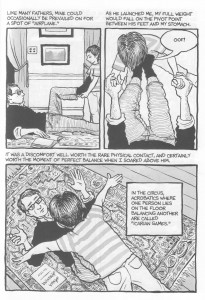
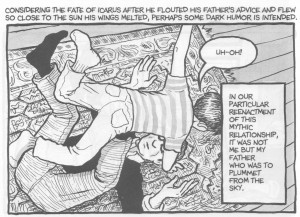

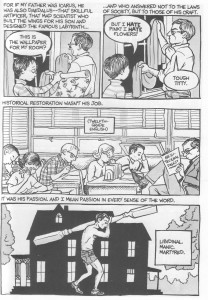
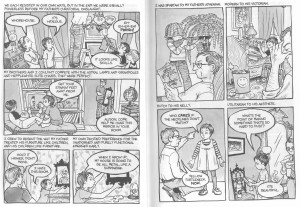
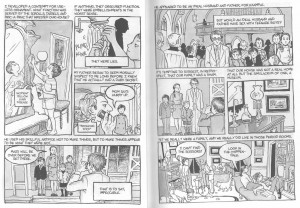
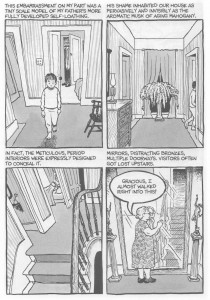
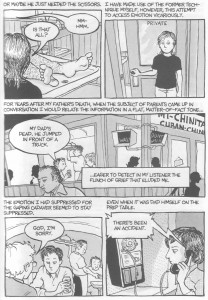


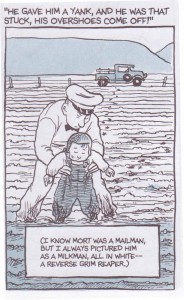



Great defense of the book, Suat. I think Fun Home got put down a lot for its lack of visual flashiness and for a literary allusiveness that is lacking in almost all comics.
I wrote about the book for an online literary journal: http://quarterlyconversation.com/fun-home-by-alison-bechdel-review
I know lots of folks love it…but man, reading those panels just makes me grit my teeth. Maybe I’ll try to write about it later in the week to spread my annoyance far and wide….
I wasn’t really attacking the comic/book per se, just saying that most of its interest (for me at least) is on the literary side, not on its use of comics form or the visuals. I actually thought of the milkman scene as a key exception…
I also think the writing vs. visual divide is thematized in the book fairly interestingly. The father is obsessed with writers and literature–and one could see Alison’s embrace of all the literary allusions as an attempt to re-embrace the dad. Her career long turn to comics (and “visual art”) might be seen as a turn away. The fact that comics themselves are NOT a theme through much of the book suggests her attempt to find common ground with dad. The Mad purchases are the exception…along with the masturbatory drawing of the basketball player. Alison as “artist” is mostly absent from the book, however—and her connection to the literary tradition is front and center.
The milkman bit is interesting, but I think it bears pointing out that a literary allusion isn’t an allusion at all if it’s being pointed out in the text. It’s a reference.
It isn’t that I have a problem with the drawing or the subject matter. It’s more that it all seems so prescribed . The author refuses to allow mystery to intrude upon her strategy. The literary references seem like a huge part of that strategy. Employed in a less on-the-nose kind of way, I think it could’ve been really effective.
I get the sense that Bechdel pulled back and , reminding herself that it’s just a graphic novel, tried to pull all these different schemes into nice little packages. Problem is, it’s a story about confusion, mystery, shame, secrets, etc. Rather than letting them loose, she seemed to want to conquer them..
Derik: Thanks for the link and nice words.
Eric: I agree with your points on the role of literary allusions and comics in Fun Home. Bechdel does use the comics form in a fashion more akin to writer/artist’s like Alan Moore. Certainly Fun Home is more similar to Watchmen or From Hell in terms of technique than, say, Brian Chippendale’s Ninja. Which is why I brought up Charles Hatfield’s comments which imply that comics can be many things. Gary’s comments suggest a more essentialist view of comics which, while I’m not entirely opposed to, has its limitations.
Uland: I think there are parts of Fun Home which work in more “mysterious” ways but there are definitely sections where your criticisms do apply – the Fitzgerald references in chapter 3 didn’t work quite as well as some if I remember correctly. It’s debatable whether Bechdel achieved the correct balance in this respect.
Noah: Looking forward to some Fun Home hate from your end. On the other hand, it might be an idea to avoid this in order to save on your dentist bill. At least that’s what I usually do with anything which grates on my nerves after an initial reading.
Ah, but you probably feel you have to actually reread something before gratuitously bashing it. Since I am unburdened by ethical considerations, my flights of bile are easier on the teeth.